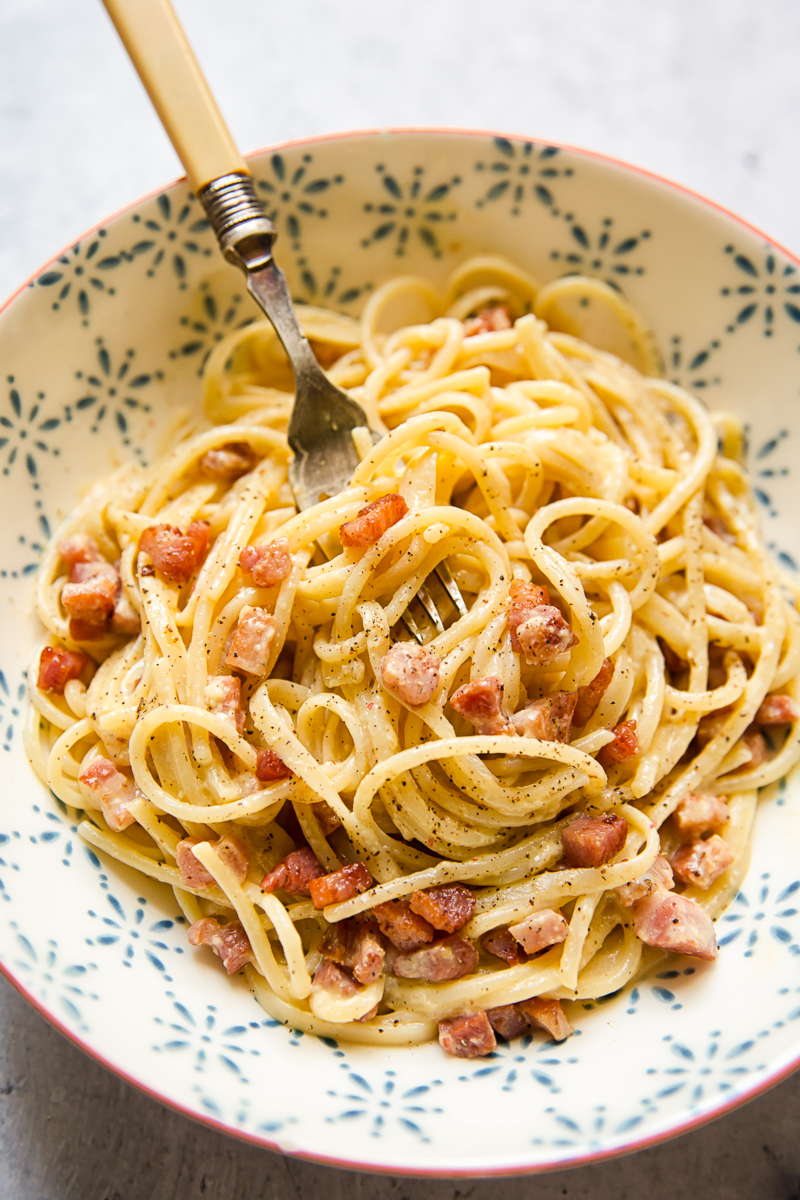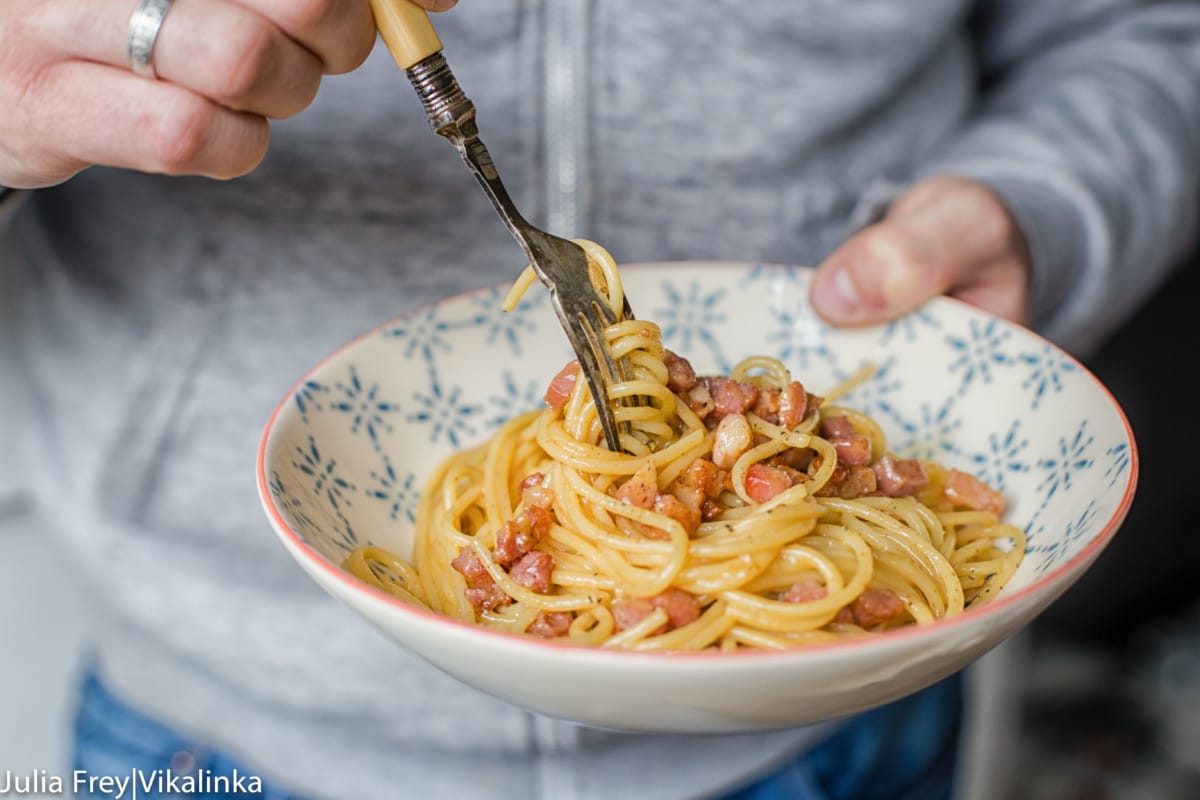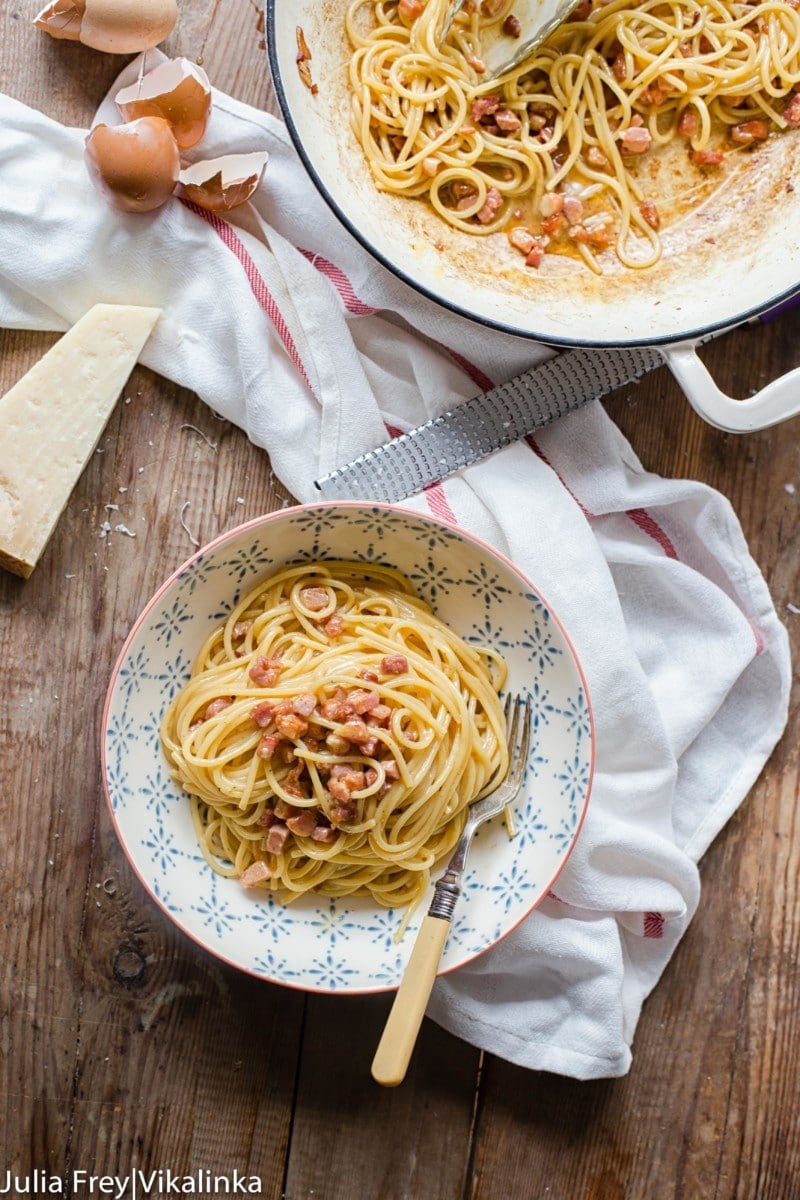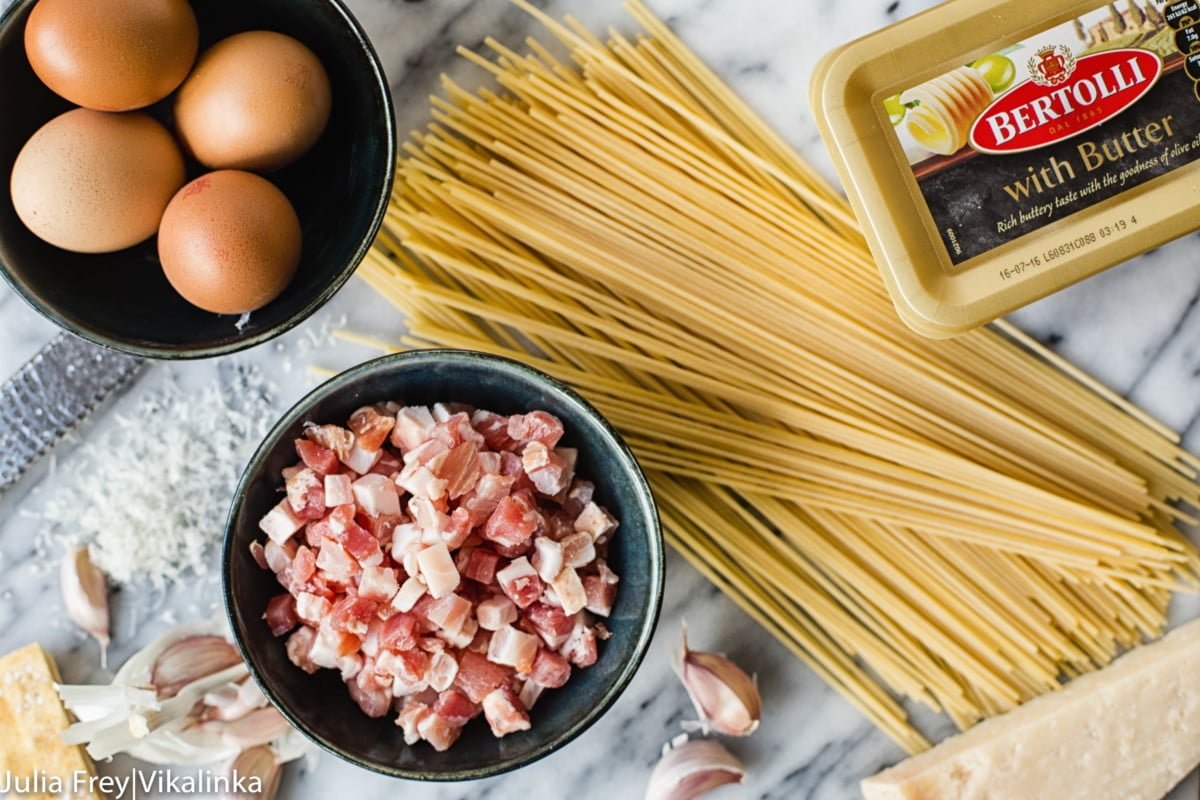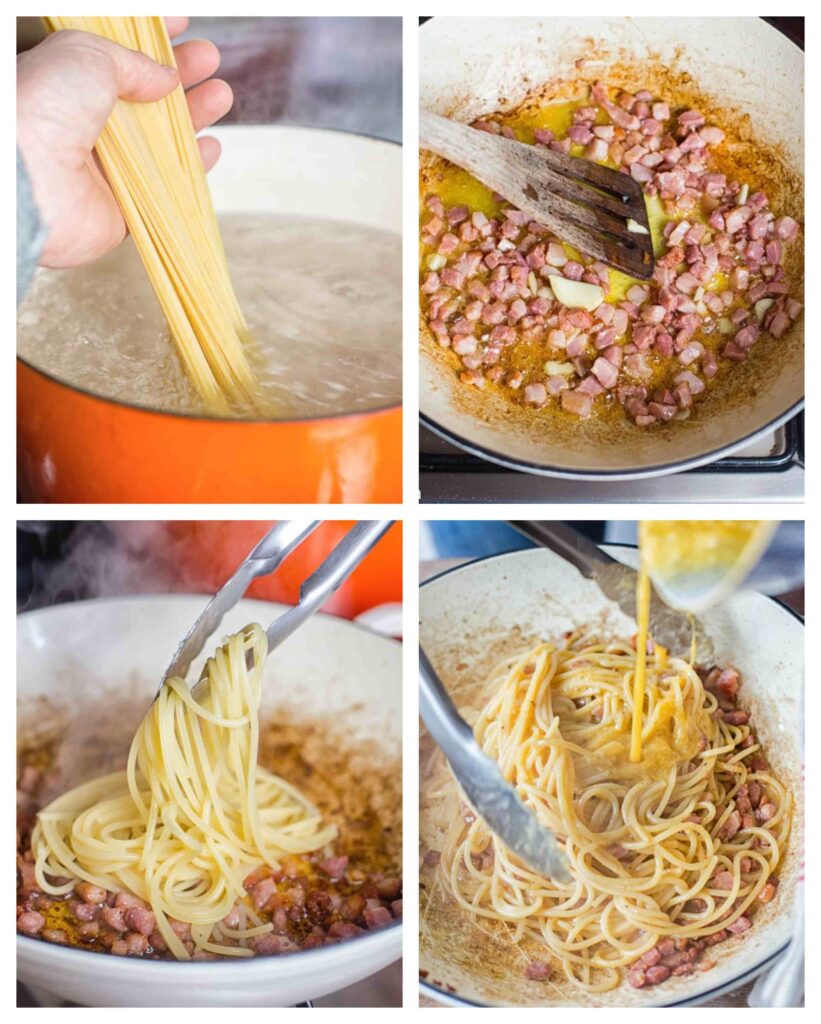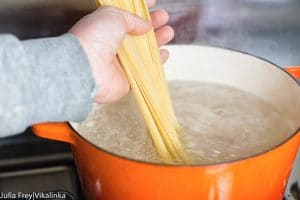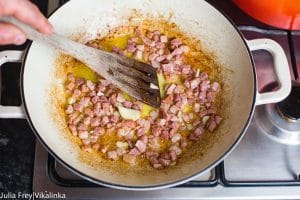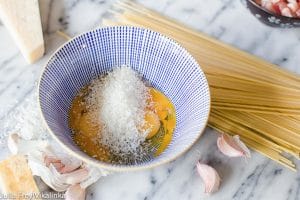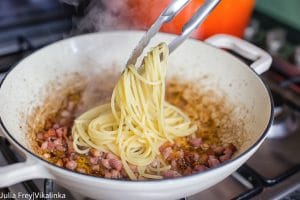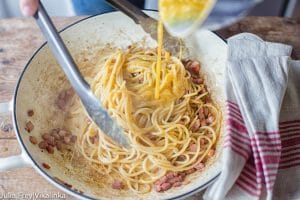Or for a meatless version of carbonara, how about my Vegetarian Mushroom Carbonara? Whenever we visit Italy we are fortunate enough to be able to see the real country, away from busy tourist spots, and eat meals prepared by real women, not chefs. Our Italian friends make sure of it! If you ever ask an Italian where to get the best food they would answer my mamma’s house without hesitation. Truth is that some of the tastiest Italian dishes ARE made by home cooks. Carbonara is the only evidence of this you need. It’s a classically simple dish using minimal ingredients but with a lusciously creamy texture and savoury flavour. I heard that Julia Child once said she didn’t like Italian cooking because there is no actual cooking involved. Seriously Julia Child? That’s my favourite part!! I love that I can come home from work and no matter what state I am in I can still whip up a quick and satisfying spaghetti carbonara and spend time with my favourite people around a dinner table.
Carbonara sauce
Although we think of spaghetti carbonara as a classic Italian dish, it’s origin may be more recent than we realise. Of course, as with many Italian dishes, there are loud and frequent arguments about its origin and no real consensus. One often repeated story is that it was invented by an Italian cooking for American soldiers in World War 2. The servicemen took fond memories of the dish with them when they went home, leading to a spread of carbonara to new continents. Others trace its origin to earlier times as there are mentions of something notably similar in old cookbooks, and that’s where I land. Spaghetti carbonara is an iconic Italian recipe but often times in restaurants it is absolutely loaded with cream, which has no place in the original recipe. All the cream and cheese makes restaurant carbonara a hefty dish we often feel guilty for eating. And it does make us feel quite heavy afterwards. But would you be surprised if I told you that the same creaminess could be achieved without the cream and the calories?
Ingredients
Traditional carbonara sauce is made from ingredients that are available in Italy but significantly harder to find elsewhere. Rather than pancetta or bacon, a cured meet from the jowl of a pig called guanciale is used. And no using Parmesan cheese here. Authentic carbonara uses Pecorino Romano, an aged cheese made from sheep’s milk. Neither guanciale or Pecorino Romano are impossible to find, but it’s not the simplest thing and as rare items outside of Italy they may come at a premium. Fortunately, pancetta or bacon with Parmesan cheese will do just fine! For such a luxuriously creamy sauce, there are surprisingly few ingredients that go into carbonara:
eggs Parmesan or Pecorino cheese pancetta or bacon salt and pepper 1 tablespoon of cream or butter (optional)
So how do we make carbonara creamy with only these ingredients to work with?
Adding creaminess
Eggs are the main ingredients in the carbonara sauce and to make it seem creamy I use mostly egg yolks. It is the yolks that are responsible for the creaminess in the sauce and that luxurious feeling you get with each mouthful without feeling greasy. Another trick is to add one tablespoon of butter to start the sauce or 1 tablespoon of cream to finish it, but not both! Well, you can do both but it’s not necessary.
How to make it
Attention to detail is important in this recipe since it has an incredibly short ingredient list. The flavour rests on the quality of those ingredients plus little finishing touches. When making pasta, always salt your water before adding the pasta. That’s a crucial step as it allows the pasta to get flavoured all the way through. If you salt it your spaghetti later it will only be on the surface. While that’s happening, add pancetta or bacon to a pan with butter along with garlic. The garlic is a little trick for adding flavour as it infuses the pancetta with its aroma. I usually add one clove of garlic to the pan when I cook the pancetta, then remove it before the pasta goes in. This way the garlic adds to the delicate flavour of the carbonara sauce without overwhelming it. When everything is ready, add the hot pasta directly to the pan with cooked pancetta, then add some pasta water. Because there is no added cream in this recipe, we need some extra liquid to create the sauce and carry the flavours that coat the pasta. Cooking water is perfect for this role as it has absorbed some starch from the pasta which will help thicken the sauce as well. Now the the trickiest step is adding the egg and cheese mixture to the pasta to create the famous carbonara sauce. I personally find it works best if I add the beaten eggs while the pasta is taken off the burner. This way you get gentle heat that will cook the egg but not curdle it. If you can manage, it works best if you pour the egg and cheese mixture over the spaghetti while tossing the pasta the entire time. This way the sauce coats the pasta and prevents the eggs from turning scrambled. Finally add more freshly grated Parmesan cheese and salt and pepper to taste.
Serving suggestions
Part of the genius of carbonara is how quick and simple it is. After all simplicity is what Italian cooking is all about! So you aren’t going to want to put tons of effort into side dishes! If you are in the mood for starters, mushroom crostini or a variety of bruschetta will do the trick nicely. One other way to round out the meal while keeping things simple is to serve an Italian version of charcuterie. A few slices of nicely sliced meats, cheese, olives and breadsticks and it’ll feel like a proper Italian feast! Personally I like to put together a simple green salad or caprese salad, which is ridiculously easy yet is fresh and fragrant in all the right ways. Just what you need with a creamy pasta dish! It’s worth noting that it’s difficult to combine the egg and cheese mixture into the pasta if making large quantities of carbonara. Although this might seem to be a tempting recipe to make for guests, I find that making for four people is the limit.
Storage and leftovers
Tempting as it may be, this is not a recipe that keeps well to enjoy later. It’s best to make only as much as you expect to eat. This might mean reducing the servings you make. If you do have a bit too much, it will store in an airtight container in the fridge for 3-4 days. Reheat in a microwave. I don’t recommend freezing.
More authentic Italian pasta recipes
Spaghetti Bolognese Pasta Cream Sauce Spaghetti Puttanesca Spaghetti alla Siciliana
